Graveyard Kitarou, a short review
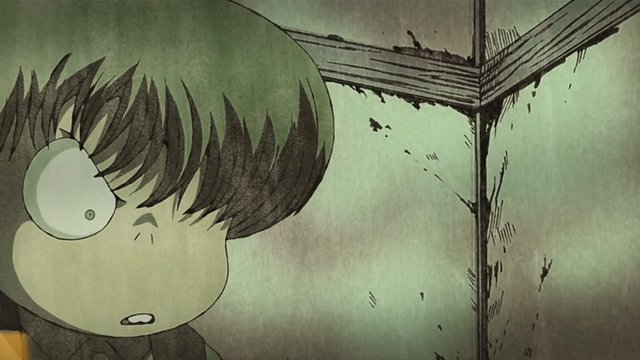
Today, I'm going to talk a bit about the origins of Hakaba Kitarou (Graveyard Kitarou), and its 2008 anime adaptation. In case you ventured into GeGeGe no Kitarou circles like I did, you would quickly find out that GeGeGe no Kitarou also had a prototypical series known as Hakaba Kitarou.
To start off, Hakaba Kitarou isn't solely a Shigeru Mizuki creation. It actually had its run from 1933 to 1935 as a kamishibai created by Masami Itou, who himself was adapting an old Japanese folktale known as Kosodate-Yuurei. But before I go on, I must explain what those are.
What is Kamishibai?
Kamishibai means paper play. It is a form of street theatre that the Japanese practiced to entertain themselves and their audiences. In an age of no television and no radio, this was what watching anime and reading manga were like for these people.
For a kamishibai to take place, you needed three items.
- Picture cards with text written at the back. (Your early 20th century equivalent of anime cells)
- A stage. It was usually made out of wood. (Your early 20th century equivalent of a television set or a laptop screen so that people could focus their attention on it)
- A narrator. (You had to narrate your story using the picture cards and present them through the stage. You also probably needed some wooden items if you wanted to add sound effects to your "anime")
What is Kosodate-Yuurei about?
I'm not much of a storyteller, so you can read all about this tale here. In short, one of the versions of the Kosodate-Yuurei story is about a ghost woman buying candy from a merchant so she can feed her new born baby she gave birth to, posthumously, in her coffin. Kitarou in Mizuki's series is that newborn baby who grew out of a graveyard.
From kamishibai to rental manga
It is a long and complicated story which you can read about here.
In 1954, Shigeru Mizuki worked as a kamishibai artist. His boss requested him that he created new stories based on Itou's kamishibai, which he managed to do so after getting permission from the original author. After working with kamishibai, Mizuki decided to tackle manga as the art form was growing in popularity, and one of the series he debuted was called Hakaba Kitarou under a publishing company. However, it was a tumultuous period for the author and his manga as he had to switch to different publishers from 1960 to 1964. It wasn't without reason, as his manga just didn't receive the mainstream success it needed to survive beyond more than a couple of stories. Weirdly enough, when Mizuki left his original publishing company over pay, the latter went on to hire Kanko Takeuchi, a new author who took over and continued his Hakaba Kitarou series while Mizuki was also continuing his own version of the Hakaba Kitarou manga under a different name. As you can imagine, It must have been a pretty wild situation for any author to be in.
In 1965, Mizuki finally attacked a different kind of market when he joined Kodansha's Weekly Shounen Magazine. He remade and renamed his manga to Hakaba no Kitarou (Kitarou of the Graveyard), and eventually to GeGeGe no Kitarou. Considering how successful this new version turned out to be in the end, it was quite evident that his manga ideas were actually sellable; they only required a few tweaks. First, he had to tone down the scary aspects of the series as the kids found the original just too damn spooky, and second, he just needed the right audience. Fortunately for him, Kodansha gave him a weekly audience that he could rely on.
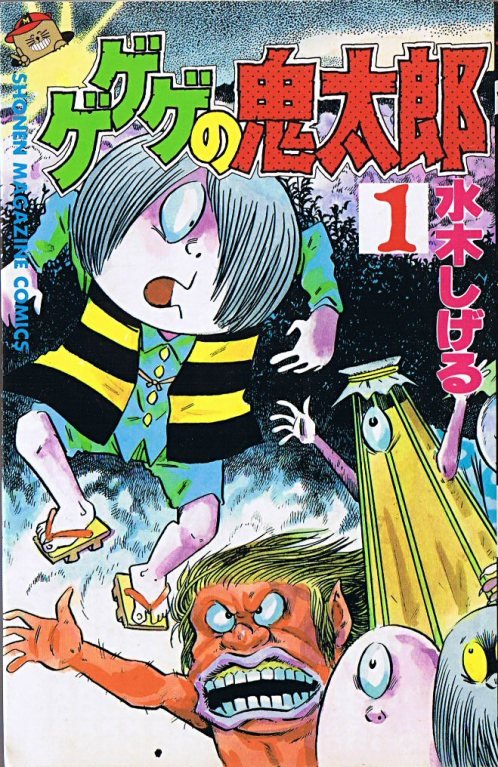
Cover of the 1st volume of GeGeGe no Kitarou
The anime adaptation
As a rental manga, Hakaba Kitarou had collected 15 stories by Mizuki, discounting the ones by Takeuchi over 4 years from 1960 to 1964. 9 of these stories would serve Toei's 2008 adaptation while 2 of them were simply additions by the anime.
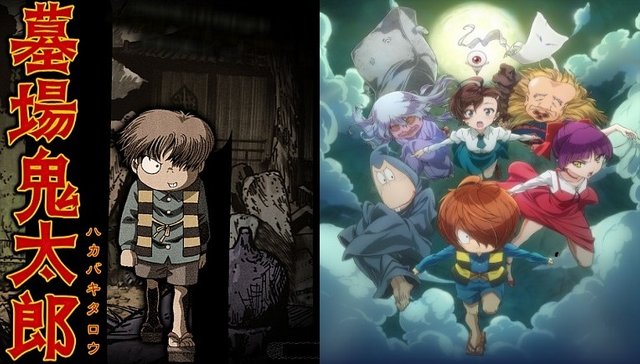
Just going by these two posters above, Hakaba Kitarou is more visually interesting compared to the 2018 version. To be fair, there’s nothing inherently wrong with the 2018 anime, but it’s perhaps way too shiny for a show that deals with youkai. Furthermore, I’d say the art style just looks more grim, to reflect on the darker original version of the story.
But just because a series looks grim, doesn't mean it also has to look dull. With that kept in mind, I can definitely vouch for Hakaba Kitarou's palette. Whoever was responsible for the visual direction of the series did a great job at bringing the colours while also keeping in mind the darker nature of the stories.
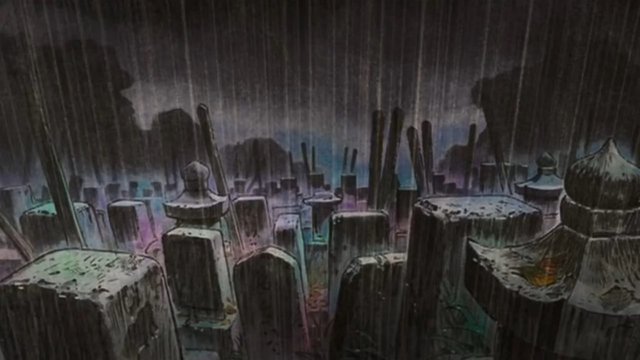
For the music, Toei is known for using the classic GeGeGe no Kitarou theme song every time they rebooted the series for a new audience, but this time, Denki Groove took charge of the opening resulting in a funky kind of music that I wouldn't generally associate with a series that deals with youkai. It is a bold choice, but not a surprising one considering the band also gave us a funky opening for this year's Devilman Crybaby, a series about demons. Yet, for the actual tracks that played throughout, I felt that they were appropriately and sufficiently creepy.
I've mentioned above that 9 episodes from this anime adapt the individual stories from Mizuki's rental manga. The other two anime-only episodes, namely Neko and Fake Kitarou while not bad, simply weren't on the same level as the others. Excluding those two, the stories presented were quirky and original and showcased a simpler time when manga artists were just concerned about telling a fun story, and not so much about having "good" and "bad" characters. In that sense, I have the impression that this aspect of old manga might have been lost when I watch the newer GeGeGe no Kitarou TV anime.
But after watching the Hakaba Kitarou adaptation, I can also understand why the original rental manga was a hard sell. For Shigeru Mizuki, someone who actually believed in the existence of youkai following his World War 2 service, writing about them must have been a real passion for him. However, in the process of doing so, I think that he couldn't quite narrow down his audience. After all, who was the Hakaba Kitarou manga really for? Technically, it was for kids, but they were too damn scared by it, and I don't think adults at the time would have wasted their time reading manga about youkai. For his shonen magazine debut, he had no other choice but to rebrand his manga to GeGeGe no Kitarou. Other than the spookier aspects that were toned down, Kitarou and the rat man were also now far more relatable as characters. Gone are the times like in Hakaba Kitarou, when they were just empty selfish assholes who couldn't care less about humans or even other youkai unless their presence benefited them directly.
From the little I've read of the Hakaba Kitarou manga, the adaptation seems fair enough, but I also know that this series isn't going to be for everyone given its episodic nature and quirky writing. If you're into the more bombastic kind, then GeGeGe no Kitarou is probably the better choice. As for me personally, I'm glad that I got to experience both. You really can't go wrong with either, especially if you too are interested in the deep youkai mythology that Shigeru Mizuki had a deep affinity with.
Beyond the Kitarou series, when Shigeru Mizuki was still with us, he also produced an excellent manga about Japan, and his service in the war. It is called Showa: A history of Japan, which does seem to be worth checking out according to this medium article. As always, see you next time for another review!
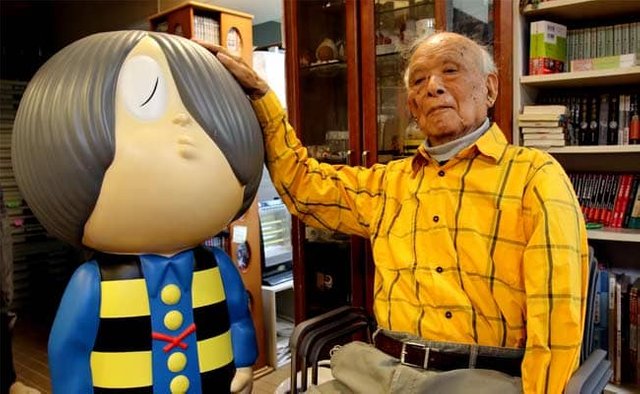
Posted from my blog with SteemPress : http://cryptotsuki.com/2018/09/13/kitarou-of-the-graveyard-a-short-review/
Thank you for this! I had only just decided to watch GeGeGe no Kitarou yesterday, and after that, I heard that it had an earlier adaptation.
Hi @eaudebla!
I am (currently @quekery) a curator for AkibaSteem and this is just to let you know that I upvoted your post :
We're an anime-focused community full of fans and good people!
We aim to find good anime & manga content, share a happy moment & give some visibility. You got our vote and your post may get featured in our compilation post, if you don't want to be featured please let us know. Keep up the great work!
Also, feel welcome to join our community on Discord! -:
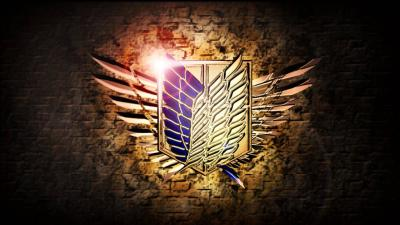
https://discord.gg/7JQruwm
The history of this anime really fascinates me, from paper play to manga to classic anime up to the present 'shinier' version. The Kosodate-Yuurei literature also makes it more interesting. I think it's a great read and I really stories like this. There's no doubt that both Kitarou and old man Shigeru will always be icons in their own rights.
Personally, I'm more fond of anime and manga from 10 or 20 years ago. They might lose in quality, brightness etc. but as they say 'nothing beats the classics'.
Anyway, thanks for sharing this. A good read.
P.S.
You have a typo here
:)
Thank you for reading and pointing out the typo. 10 or 20 years ago feel recent to me, even though it's been quite a while relatively speaking.
Many anime have awesome backstories, sometimes even more interesting than the anime in question. It just takes a little bit of research to make me appreciate a work even more. I rewrote this post plenty of times because I wasn't satisfied with it.
After all, I only tackled one portion of Mizuki's history. I linked an awesome medium article that you must absolutely read, and if you can, get the manga as well. I know I will order it soon whenever I can.
Also, here's another factoid I didn't mention about Mizuki. He actually lost his arm in the war, and was drawing manga with only one arm since.
Wow, that's cool to know. Drawing with one arm is very hard and yet he produced such an awesome work.
I agree, some backstories are even more interesting than the finished work themselves.
I only started hearing about this guy after he died.
Unfortunately that's the case for celebrities as well. It's always good to go back and experience one's work again.
Congratulations @eaudebla! You have completed the following achievement on the Steem blockchain and have been rewarded with new badge(s) :
Click on the badge to view your Board of Honor.
If you no longer want to receive notifications, reply to this comment with the word
STOPThe anime industry has indeed embedded and has marked a lot through our coutry Philippines and that made me hooked to this blog. I haven't read or watched Kitarou of the Graveyard but you absolutely guided me into understanding it. From its history up to the plot of the story. You did absolutely well. Worthy to be read and worthy for the value of upvote. Cool!
Yes, I heard all about the Voltes V debacle with your past dictator Ferdinand Marcos. It's a fascinating period of history, indeed. Thanks for the upvote and comment.
This papper game as well as the anime have something very original, the adaptation surprised me quite because they were very different, but both very attractive, so you can see in the covers, they are charming. The image you chose from the cover was perfect although my inclination goes for the anime, hahaha. Very good review, I hope to see more posts of you innovators.
Thank you. I enjoy both series too.
Well, bad stuff first: you made a small typo in the images, saying gegege on the left and hakaba to the right, it's viceversa ;)
Moving on, I now understand better why you were talking with me about gegege, unfortunately the 2018 animations are a BIG turnoff for me, look at that 2008 animation and style, so much better!
The audience problem must have been quite something else, because talking about the serious yokai stories in the setting they're supposed to be it's going to be scary and creepy as hell, no wonder the kids didn't read it (and the parents didn't give it to the kids).
But toning it down a bit was acceptable, just that I think the 2018 version toned it down too much, to the point I found it hard to be invested in it despite being a fan of yokai and japanese shinto religion.
Well, a nice, good review like always touching some interesting anime that aren't so known!
Yes I noticed and corrected the mistake. Thanks. The 2018 anime is beautifully animated though, and it's actually plenty of fun, but it is geared more towards the shonen Dragonball audience than Youkai enthusiasts.
By toning down, it was Shigeru Mizuki who did that himself. He had to for his new audience. After all, we're already on like the 6th anime iteration of the GeGeGe no Kitarou franchise excluding Hakaba Kitarou, so it was massively successful.
The new GeGeGe no Kitaro does keep the creepy aspects though so I wouldn't say it's all gone. It's just heavily mixed with the shonen elements like plenty of Dragonball-like action.
Also thanks for your comment, and yeah, articles like these help me express in better terms what I really meant when I have these anime discussions with you.
The only thing I don't like is the fact I can't give bigger votes. You really go out of your way to make good stuff about not "mainstream" anime, that's worth gold from my viewpoint.
Thanks. I had another article coming up but I couldn't take any message from it and thus couldn't reasonably conclude it. Hopefully, I'll come back later and finish it. Meanwhile, I'm working on another one I have planned.
Talked about Hakaba Kitarou, I think a lot of us read the manga before and I was one of them. But sadly I didn't know the history until i read your article. Thank you for your research and share with us how it evolve from paper play until today version. It mean a lot to Hakaba Kitarou lovers.
If compare Hakaba Kitarou version and 2018 version. I still prefer the old Hakaba Kitarou version. Maybe because it was the first version i have read and it brought back my memory.
Good article @eaudebla
Thank you. I actually didn't read much of the manga but I got the gist of the stories through the anime adaptation. The part about the paper play surprised me too, and I was fascinated by it during my research for this article. I'm actually a very new GeGeGe no Kitarou fan. Although I knew of Shigeru Mizuki for a pretty long time, it wasn't till the 2018 version that I started getting into his works.
Great that you share with us about the paper play. It really amazing.
Holy shit, I have to watch this. No wonder I chose to 100% upvote you every time. Your posts take my breath away.
Yes do watch it. It isn't the kind of series that gets made every day. I actually wrote an earlier version of the article which I published accidentally because of the Steempress plugin. I saw your upvote and my crappy post after an hour it was on Steem and didn't even realise it since I was editing it in Wordpress. I have another post in my blog called inconstruction. It was the same silly me who forgot to uncheck the publish to steem checkbox on Wordpress, lol.
And thanks for your support as always, felipe.